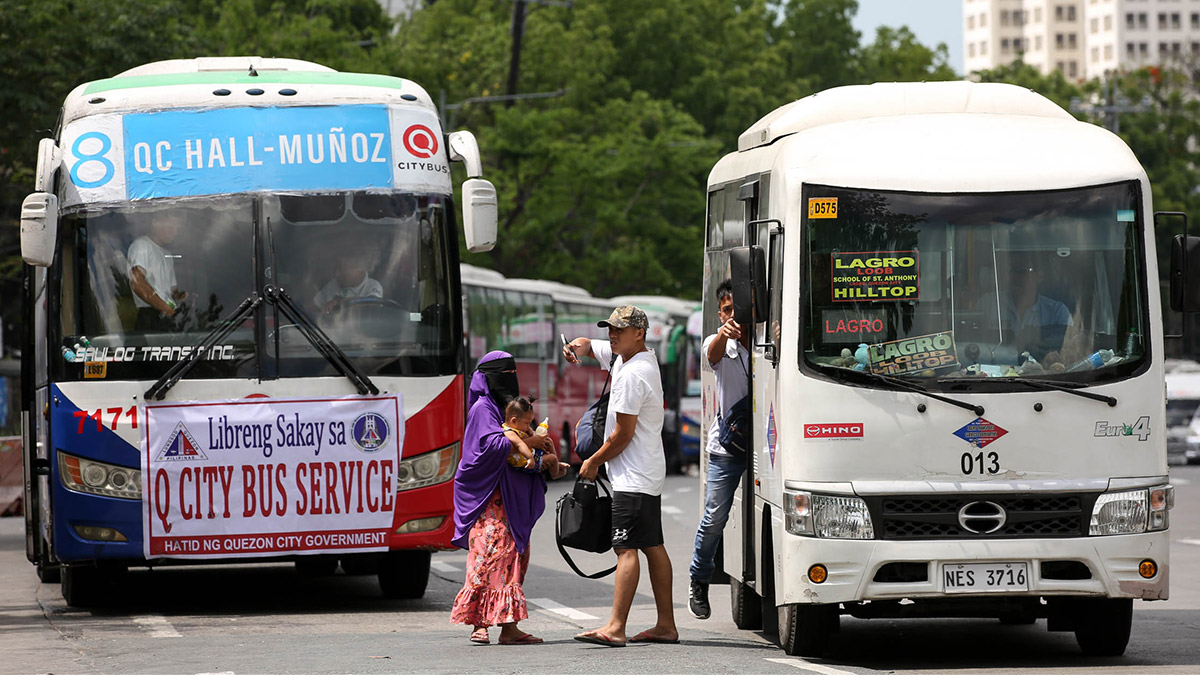This is not a successful transport strike–DOTr

FREE RIDE Buses tapped by the Quezon City government to give stranded commuters a free ride wait for passengers on Elliptical Road on Monday during a transport strike staged by the groups Piston and Manibela. Modern jeepneys, however, continued plying their routes. LYN RILLON
MANILA, Philippines — Government officials have downplayed the first of the two-day strike by two transport groups on Monday, saying that no part of the country, particularly Metro Manila, was paralyzed by their protest.
But officials of the Department of Transportation (DOTr) also conceded that the government and the two most vocal critics of the public utility vehicle modernization program (PUVMP) have already reached a deadlock two weeks before the April 30 deadline for operators to consolidate into cooperatives or corporations.
Jesus Ferdinand Ortega, DOTr undersecretary for road transport and infrastructure, said the latest strike by Piston and Manibela failed anew and just made the commuting public suffer amid the intense summer heat.
“With all humility, this is not a successful transport strike. Only a handful of PUV drivers and operators joined them across the country. In the NCR (National Capital Region), more could have joined them, but we are on top of the situation,” he said in a radio interview.
Like any other day
Land Transportation Franchising and Regulatory Board (LTFRB) Chair Teofilo Guadiz III agreed, saying that the movement of vehicles and commuters on Monday was similar to any other regular day.
“There is continuous traffic of vehicles and commuters riding public transportation. We have not observed long lines of stranded passengers,” he said.
Guadiz said the LTFRB had prepositioned “rescue buses” in case there would be a shortage of PUVs and stranded passengers would need to be ferried.
“But we have not seen the need to deploy these buses. Based on our monitoring of key areas in Metro Manila, there is still an adequate number of PUVs to serve our commuting public,” he said.
The Metropolitan Manila Development Authority (MMDA) also monitored no transport disruptions. MMDA acting Chair Romando Artes said the agency had yet to deploy any of their 400 vehicles to ferry stranded passengers in different parts of the metropolis.
Artes claimed he had talked with some members of the two transport groups, saying the MMDA would still pick up passengers in the morning before joining the strike.
“This is where we see that transport strikes first affect members of transport groups. Why? Because transport strikes cause them to lose potential earnings,” he said.
‘Police harassment’
Piston and Manibela, however, disputed the government’s assertions, saying that “80 percent of major routes in Metro Manila, including parts of Cavite and Laguna, have been paralyzed, while Bacolod City experiences a 90-percent paralysis due to the strike.”
Public transport continued as usual in Bacolod City.
The United Negros Drivers and Operators Center and Bacolod Alliance for Commuters, Operators and Drivers staged protest caravans to oppose the jeepney modernization program and a small rally in front of the Fountain of Justice at Araneta Street in Bacolod.
But other groups, such as the Samahan ng Tsuper at Operators Nationwide and the Federation of Bacolod City Drivers Association, did not take part in the protests.
In a statement, Piston said: “The government’s attempts to downplay the strike’s impact are futile. Stranded commuters line Commonwealth Avenue and other major routes, while schools and universities have suspended classes or shifted to online, and the massive police presence that aims to quell mobilizations only goes to show the impact of the strike.”
According to the Manila Public Information Office, free transportation was provided to 126 stranded passengers across 11 routes in the country’s capital from 6 a.m. to 7 p.m.
In Pasay City, the local government deployed a bus, five vans and 10 e-trikes for stranded commuters.
Piston also claimed that there were instances of “police harassment” against their members in both Metro Manila and Southern Tagalog.
A report aired on dzBB reported that over 20 jeepneys from Rizal province were stopped by the Quezon City police on their way to join protests at the University of the Philippines Diliman campus.
At the university, there were heated encounters between protesters and Quezon City policemen, who allegedly tried to block the jeepneys from proceeding to a demonstration in Manila.
Wait for SC ruling
The DOTr and the LTFRB have yet to give an update on the PUV consolidation rate after President Ferdinand Marcos Jr. in January moved the deadline yet again to April 30.
The consolidation rate had barely moved to around 80 percent last month, translating to around 150,000 of the 190,000 PUVs across the country joining a transport cooperative or corporation.
In NCR, the consolidation rate was merely 59 percent, the lowest among all the 17 regions in the country.
This means that around 40,000 PUVs in the country that failed to consolidate would be deemed “colorum,” or illegally operating, by next month.
According to Ortega, who previously headed the DOTr’s Office of Transportation Cooperatives, the agency was already made aware even before the previous deadline of Dec. 31 that the two transport groups would not accede to the government’s consolidation process.
He said both the government and the transport groups should wait for the Supreme Court decision on the fate of the PUVMP. —WITH REPORTS FROM RUSSEL LORETO, CARLA GOMEZ AND INQUIRER RESEARCH














